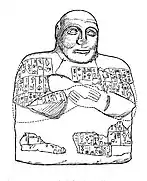Umma
Umma (Sumerian: 𒄑𒆵𒆠 ummaKI;[1] in modern Dhi Qar Province in Iraq, formerly also called Gishban) was an ancient city in Sumer. There is some scholarly debate about the Sumerian and Akkadian names for this site.[2] Traditionally, Umma was identified with Tell Jokha. More recently it has been suggested that it was located at Umm al-Aqarib, less than 7 km (4.3 mi) to its northwest or was even the name of both cities.[3][4][5] One or both were the leading city of the Early Dynastic kingdom of Gišša, with the most recent excavators putting forth that Umm al-Aqarib was prominent in EDIII but Jokha rose to preeminence later.
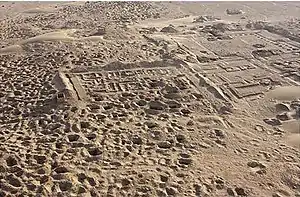 Aerial view of Umma | |
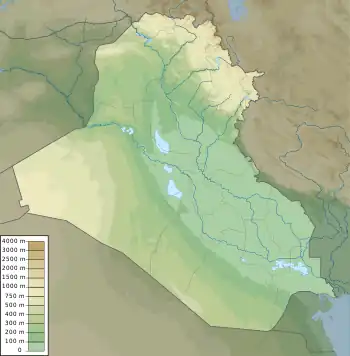 Umma Shown within Iraq | |
| Location | Dhi Qar Province, Iraq |
|---|---|
| Region | Mesopotamia |
| Coordinates | 31°40′02″N 45°53′15″E |
| Type | Settlement |
| Site notes | |
| Archaeologists | William Loftus, John Punnett Peters |
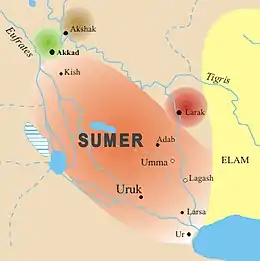
History
In the early Sumerian text Inanna's descent to the netherworld, Inanna dissuades demons from the netherworld from taking Shara, patron of Umma, who was living in squalor. They eventually take Dumuzid king of Uruk instead, who lived in palatial opulence.[6]
Best known for its long frontier conflict with Lagash, as reported c. 2400 BC by Entemena,[7] the city reached its zenith c. 2350 BC, under the rule of Lugal-Zage-Si who also controlled Ur and Uruk. Under the Ur III dynasty, Umma became an important provincial center. Most of the over 30,000 tablets recovered from the site are administrative and economic texts from that time. They permit an excellent insight into affairs in Umma.[8] The Umma calendar of Shulgi (c. 21st century BC) is the immediate predecessor of the later Babylonian calendar, and indirectly of the post-exilic Hebrew calendar. Umma appears to have been abandoned after the Middle Bronze Age.[5]
Archaeology

The site of Tell Jokha was visited by William Loftus in 1854 and John Punnett Peters of the University of Pennsylvania in 1885.[9][10] In the early 1900s, many illegally excavated Umma tablets from the Third Dynasty of Ur began to appear on the antiquities market.[11] From 1999 to 2002 Jokha was worked by an Iraqi team, recovering a number of tablets and bullae from the Early Dynastic, Sargonic, Ur III, and Old Babylonian periods.[12][13][14] In 2017, the Slovak Archaeological and Historical Institute began excavations at Tell Jokha.[15]
The site of Umm al-Aqarib (located at 45.80°E longitude and 31.60°N latitude) covers about 5 square kilometers and is made up of 21 mounds the largest of which is 20 meters above the level of the plain. The location was first visited by John Punnett Peters in the 1800s. It was excavated for a total of 7 seasons in 1999–2002 and 2008–2010 by Iraqi archaeologists under difficult conditions. At Umm al-Aqarib, archaeologists uncovered levels from the Early Dynastic Period (c. 2900–2300 BC), including several monumental buildings, one of them variously identified as a temple or palace.[5][16]
The site of Tell Shmet also lies nearby, around 10 kilometers to the northwest of Umma and within visual distance of Zabala. It was part of the Umma province. The site measures 990 by 720 meters (712,800 square meters). The main Sargonic and Ur III remains of the site were destroyed by a Ministry of Agriculture program to plant trees so as to prevent sand dunes. In response to looting which began in 1994 the Iraqi State Board of Antiquities and Heritage conducted salvage excavations in 2001 and 2002 under Mohammad Sabri Abdulraheem.[17][18][19][20] All of the paper records of the excavation were lost in looting of residential areas after the 2003 war. Plano-convex bricks and a residential area of the Early Dynastic III and Akkadian periods were uncovered. Finds included 67 clay cuneiform tablets, dozens of cylinder seals, and a number of stone and metal objects. The tablets mostly date ED III with the latest being Ur III. The tablets support the proposal that the ancient name of the site was Ki.anki. They mention the names of the gods Ninazu and Dumuzi-Maru. Only some of the tablets have been published.[21]
 Stele of Ushumgal, 2900-2700 BC. Probably from Umma.[22]
Stele of Ushumgal, 2900-2700 BC. Probably from Umma.[22]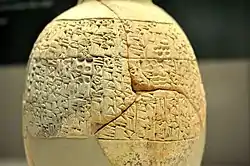
 Votive plaque offered by Bara-irnun, queen of Umma, to God Šara in gratitude for sparing her life. Date c. 2370 BC.[23]
Votive plaque offered by Bara-irnun, queen of Umma, to God Šara in gratitude for sparing her life. Date c. 2370 BC.[23]
Looting
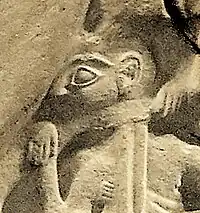
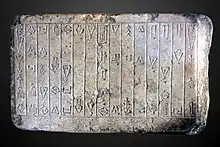
During the 2003 invasion of Iraq, after Coalition bombing began, looters descended upon the site which is now pockmarked with hundreds of ditches and pits. The prospects for future official excavation and research were seriously compromised in the process.[24]
In 2011, Global Heritage Network, which monitors threats to cultural heritage sites in developing nations, released aerial images comparing Umma in 2003 and 2010, showing a landscape devastated by looters' trenches during that time—approximately 1.12 square km in total.[25] Additional images relevant to the situation at Umm al-Aqarib are included in Tucker's article on the destruction of Iraq's archaeological heritage.[26]
Rulers of Umma
Aga of Kish (26th century BC), king of Kish, probably took over Umma, and consequently Zabala, which was dependant of it in the Early Dynastic Period.[27]
First Dynasty of Umma
| Ruler | Proposed reign | Notes | |
|---|---|---|---|
| Pabilgagaltuku | c. 2500 BC | A governor of Umma, he was captured by Ur-Nanshe of Lagash.[28] | |
| Ush ("Ninta") |  | c. 2450 BC | Attacked Lagash and removed the boundary stone set up by Mesilim, and was defeated by Eannatum.[28] |
| Enakalle | c. 2440 BC | Made a boundary treaty with Eannatum.[29] | |
| Ur-Lumma | c. 2430 BC | Son of Enakalle. Challenged Enannatum I, but was defeated by his successor Enmetena.[29][28] | |
| Il | c. 2420 BC | Successor to Ur-Lumna. He rebelled against Enannatum II, and destroyed the dynasty of Ur-Nanshe.[29] | |
| Gishakidu | c. 2410 BC | Son of Il[28] | |
| Edin | c. 2400 BC | Ruler of Umma [28] | |
| Me'annedu | c. 2400 BC | Ruler of Umma, reigned at least 29 years[28][30] | |
| Ushurdu? | c. 2370 BC | Ruler of Umma[28] | |
| Ukush | c. 2360 BC | Father of Lugal-Zage-Si.[28] | |
| Lugal-Zage-Si |  | c. 2350 BC | Conqueror of all Sumer, founder of the third dynasty of Uruk, vanquished by Sargon of Akkad.[28] |
Second Dynasty of Umma
| Ruler | Proposed reign | Notes | |
|---|---|---|---|
| Lugalanatum | c. 2120 BC | Vassal to the Gutian Dynasty.[28] |
See also
References
- "ORACC – Umma".
- Lambert, W. G. (1990). "The Names of Umma". Journal of Near Eastern Studies. 49 (1): 75–80. doi:10.1086/373421. ISSN 0022-2968. JSTOR 544410. S2CID 162374749.
- Bartasch, Vitali (2015). "On the Sumerian City UB-meki, the Alleged "Umma"". Cuneiform Digital Library Bulletin. 2. ISSN 1540-8760.
- Almamori, Haider O. (2014). "Gišša (Umm Al-Aqarib), Umma ( Jokha), and Lagaš in the Early Dynastic III Period". Al-Rāidān. 35: 1–37.
- Bryce, Trevor (2012). The Routledge handbook of the peoples and places of ancient western Asia : the Near East from the early Bronze Age to the fall of the Persian Empire. London: Routledge. ISBN 978-0-415-69261-8. OCLC 767524716.
- "Inana's descent to the nether world". Electronic Text Corpus of Sumerian Literature. Retrieved 2021-07-22.
- Cooper, Jerrold S. (1983). Reconstructing history from ancient inscriptions : the Lagash-Umma border conflict. Malibu: Undena Publications. ISBN 0-89003-059-6. OCLC 10304478.
- Parr, P. A. (1972-06-01). "A Letter of Ur-Lisi, Governor of Umma". Journal of Cuneiform Studies. 24 (4): 135–136. doi:10.2307/1359635. ISSN 0022-0256. JSTOR 1359635. S2CID 163250537.
- Loftus, William K. (1857). Travels and Researches in Chaldaea and Susiana, Travels and Researches in Chaldaea and Susiana: With an Account of Excavations at Warka, the "Erech" of Nimrod, and Shush, "Shushan the Palace" of Esther, in 1849–52. Robert Carter & Brothers.
- Peters, John P. (1897). Nippur; Or, Explorations and Adventures on the Euphrates: The Narrative of the University of Pennsylvania Expedition to Babylonia in the Years 1888–1890 (PDF). University of Pennsylvania Babylonian Expedition. Putnam.
- Georges Contenau, Contribution a l'Histoire Economique d'Umma, Librairie Champion, 1915
- Almamori, H. O., "Gišša (Umm Al-Aqarib), Umma (Jokha), and Lagaš in the Early Dynastic III Period", Al-Rafidan 35, pp. 1–37, 2014
- Al-Mutawalli, N.. "Administrative Cuneiform Texts from Umma in the Iraq Museum Excavation of Shara Temple (1999–2000)", Sumer 55, pp. 45–86, 2010
- Mutawalli, Nawala Ahmed al-; Ismaʻel, Khalid Salim; Sallaberger, Walther; Harbi, Hamza Shahad al-; Otto, Adelheid (2019). Bullae from the Shara Temple = Wuṣūlāt at-tasallum (bulla) min maʻbad aš-Šārā. ISBN 978-3-447-11159-1. OCLC 1101969238.
- Drahoslav Hulínek and Tibor Lieskovský, Report Archaeological project SAHI - Tell Jokha, 2016, Slovak Archaeological and Historical Institute, 2016
- Almamori, Haider Oraibi (2014). "The Early Dynastic Monumental Buildings at Umm Al-Aqarib". Iraq. 76: 149–187. doi:10.1017/irq.2014.10. ISSN 0021-0889. JSTOR 43307193. S2CID 232251022.
- Abdulraheem, M. S., "The final report of the excavations in Shmet – 1st season 2001", SBAH, Ministry of Culture, Rep. of Iraq (in Arabic), 2001
- Abdulraheem, M. S., "Prospecting at the site of Shmeet 2001–2002", Sumer 52, pp. 201–241 (in Arabic) 2003
- Abdulraheem, M. S., "The site of Shmet in the light of archaeological excavations", Unpublished Ph. D. thesis submitted to the Dept. of Archhaeology, College of Arts, University of Baghdad (in Arabic), 2014
- Abdulraheem, M. S. and B. K. Abboodi, "The final report of the excavations in Shmet – 2nd season 2002", SBAH, Ministry of Culture, Rep. of Iraq (in Arabic), 2002
- Salman Fahad, Sa’ad and Abdul-Qadir Abbas, Raghad., "Cuneiform Tablets from Shmet from the Excavation Season of 2001", Zeitschrift für Assyriologie und vorderasiatische Archäologie, vol. 110, no. 1, pp. 1-13, 2020
- "Stele of Ushumgal". www.metmuseum.org.
- "Site officiel du musée du Louvre". cartelfr.louvre.fr.
- "Simon Jenkins: In Iraq's four-year looting frenzy, allies the vandals". the Guardian. 2007-06-07. Retrieved 2021-07-23.
- "Satellite Imagery Briefing: Monitoring Endangered Cultural Heritage Sites" (PDF). Global Heritage Fund. Retrieved 2021-07-23.
- Diane Tucker (21 September 2009). "Brutal Destruction of Iraq's Archaeological Sites Continues". uruknet.info.
- Frayne, Douglas (2009). The Struggle for Hegemony in "Early Dynastic II" Sumer. The Canadian Society for Mesopotamian Studies 2010. pp. 65–66.
- Sallaberger, Walther; Schrakamp, Ingo (2015). History & Philology (PDF). Walther Sallaberger & Ingo Schrakamp (eds), Brepols. pp. 74–80. ISBN 978-2-503-53494-7.
- Van De Mieroop, Marc (2004). A History of the Ancient Near East: Ca. 3000-323 BC. Wiley. pp. 50–51. ISBN 9780631225522.
- Armando Bramanti, "Three Administrative Texts from the Time of Me’annedu", Journal of Cuneiform Studies, vol. 69, pp. 33–47, 2017
- King, L. W. (Leonard William) (1910). A history of Sumer and Akkad : an account of the early races of Babylonia from prehistoric times to the foundation of the Babylonian monarchy. London : Chatto & Windus. p. 96.
Further reading
- B. Alster, Geštinanna as Singer and the Chorus of Uruk and Zabalam: UET 6/1 22, JCS, vol. 37, pp. 219–28, 1985
- Tonia M. Sharlach, Provincial taxation and the Ur III State, Brill, 2003, ISBN 90-04-13581-2
- Trevor Bryce, The Routledge Handbook of The Peoples and Places of Ancient Western Asia: The Near East from the Early Bronze Age to the fall of the Persian Empire, Routledge, 2009
- B. R. Foster, Umma in the Sargonic Period, Memoirs of the Connecticut Academy of Arts and Sciences, vol. 20, Hamden, 1982
- Georges Contenau, Umma sous la Dynastie d'Ur, Librarie Paul Geuthner, 1916
- Jacob L. Dahl, The Ruling Family of Ur III Umma: A Prosopographical Analysis of an Elite Family in Southern Iraq 4000 Years ago, Nederlands Instituut voor het Nabije Oosten/Netherlands Institute for the Near East (NINO), 2007, ISBN 90-6258-319-9
- Shin T. Kang, Sumerian economic texts from the Umma archive, University of Illinois Press, 1973, ISBN 0-252-00425-6
- Rost, Stephanie, and Angelo Di Michele, "Systematic Versus Random Sampling in Approaches to Landscape Archaeology: The Umma Survey Project in Southern Mesopotamia", Journal of Field Archaeology 47.5, pp. 285-304, 2022
- Diana Tucker, "Brutal Destruction of Iraq's Archaeological Sites Continues", online article from September 21, 2009 posted on www.uruknet.info, http://www.uruknet.info/?p=58169
- van Driel, G. "The Size of Institutional Umma." Archiv Für Orientforschung, vol. 46/47, 1999, pp. 80–91
External links
 Media related to Umma at Wikimedia Commons
Media related to Umma at Wikimedia Commons- Photograph of site looting - Oriental Institute
- The Province of Umma - CDLI
- Brutal Destruction of Iraq's Archaeological Sites Continues

